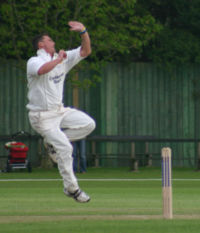- Overarm bowling
-
 English cricketer Darren Gough about to deliver the ball overarm-style.
English cricketer Darren Gough about to deliver the ball overarm-style.
Bowling techniques Deliveries Historical Styles In cricket, overarm bowling refers to a delivery in which the bowler's hand is above shoulder height. This is in contrast to a roundarm delivery, where the hand is between shoulder height and waist height; and an underarm delivery where the bowler's hand is below waist height.
After roundarm was legalised in 1835 with the bowler allowed to deliver the ball at shoulder height, it was not long before some bowlers began to raise the hand above the shoulder. The Laws of Cricket at that time directed that such a delivery be called a no ball. In 1845, the law was strengthened by removing the benefit of doubt from the bowler in height of hand questions, the umpire's view of the incident being final.
Even so, it was only a matter of time before confrontation occurred. The problem was that many umpires were themselves bowlers and believed that the bowler should be allowed to bowl with a fully raised hand. The watershed was reached on 26 August 1862 at The Oval when Surrey hosted All-England. The England bowler Edgar Willsher deliberately bowled overarm and was no-balled six times in succession by umpire John Lillywhite, ironically the son of William Lillywhite, the famous bowler who had done so much to have roundarm legalised in 1835.
In what was surely a pre-rehearsed demonstration, Willsher and the other eight professionals in the England team staged a walkoff, leaving their two amateur colleagues looking non-plussed in the middle. Play continued next day, but Lillywhite diplomatically withdrew and was replaced by another umpire.
MCC responded to this "crisis" with rather more haste than they had to roundarm and changed the Laws of Cricket in time for the 1864 season. Law 10 was rewritten to allow the bowler to bring his arm through at any height providing he kept it straight and did not throw the ball. This completed the evolution of bowling and the overarm style has remained predominant ever since, though some conservatives (including W G Grace, no less) did continue to bowl roundarm till the end of their careers; and even underarm itself was still seen occasionally.
An interesting historical development of the legalisation of overarm was that for many years, 1864 was deemed to mark the start of "first-class cricket" which suggested that earlier cricket was "second-class". The 1864 origin has been strongly challenged: see also First-class cricket.
References
External sources
Further reading
- Arthur Haygarth, Scores & Biographies, Volume 7 (1861-1862), Lillywhite, 1863
- Arthur Haygarth, Scores & Biographies, Volume 8 (1863-1864), Lillywhite, 1865
- H S Altham, A History of Cricket, Volume 1 (to 1914), George Allen & Unwin, 1962
- Derek Birley, A Social History of English Cricket, Aurum, 1999
- Rowland Bowen, Cricket: A History of its Growth and Development, Eyre & Spottiswoode, 1970
- John Major, More Than A Game, HarperCollins, 2007
Categories:- Cricket terminology
- Bowling (cricket)
Wikimedia Foundation. 2010.
